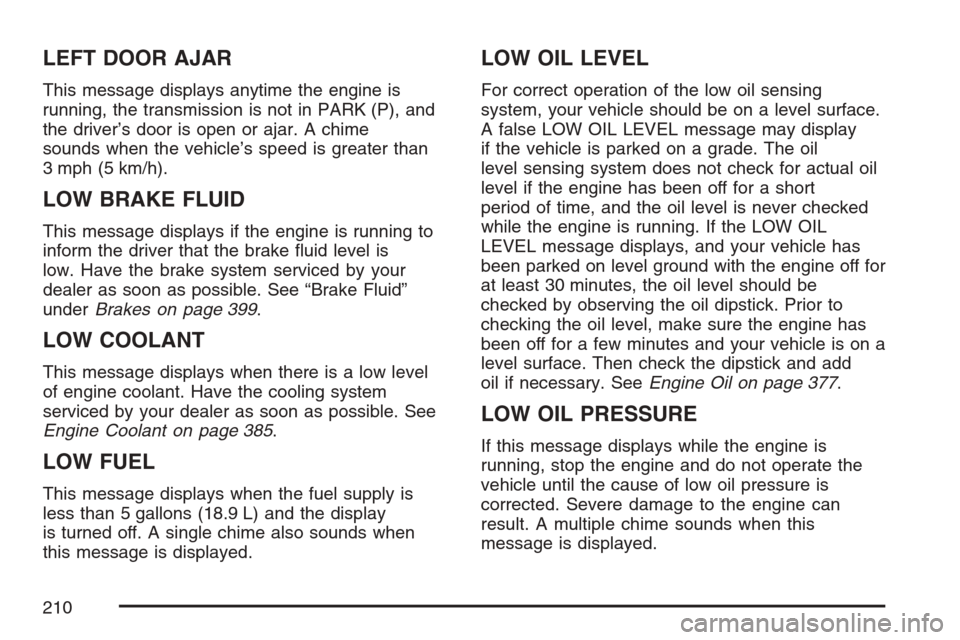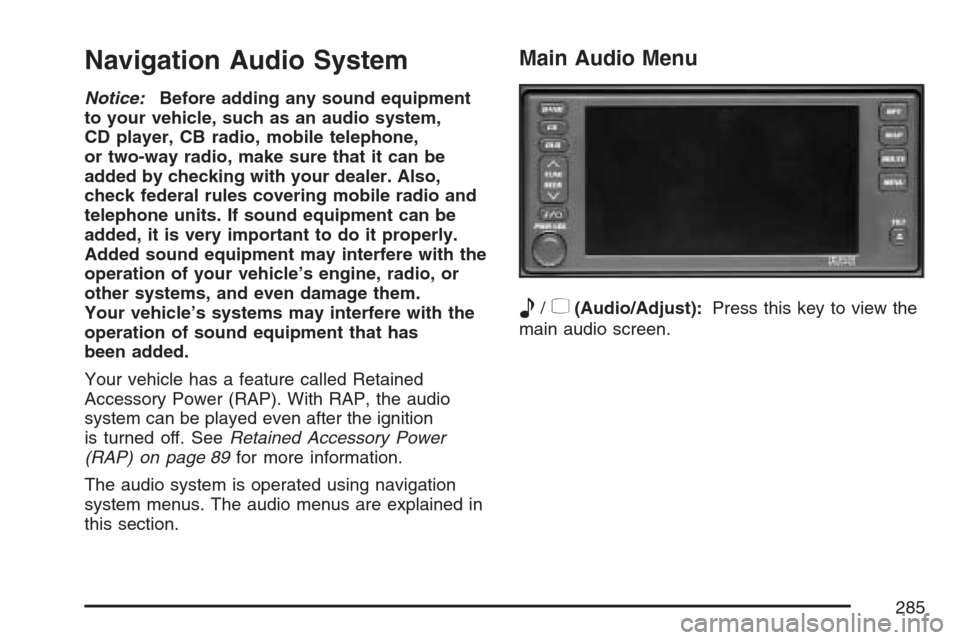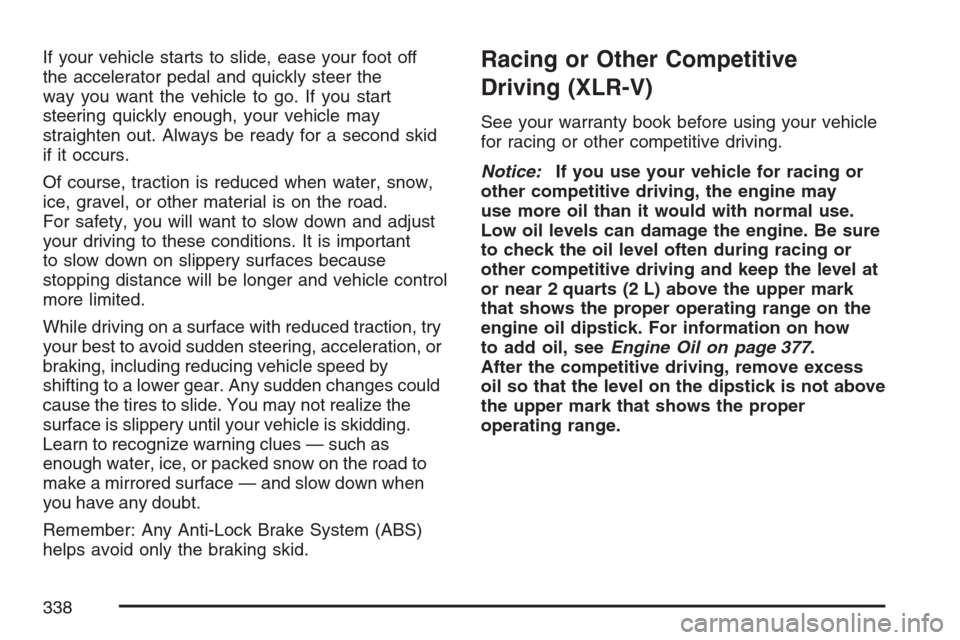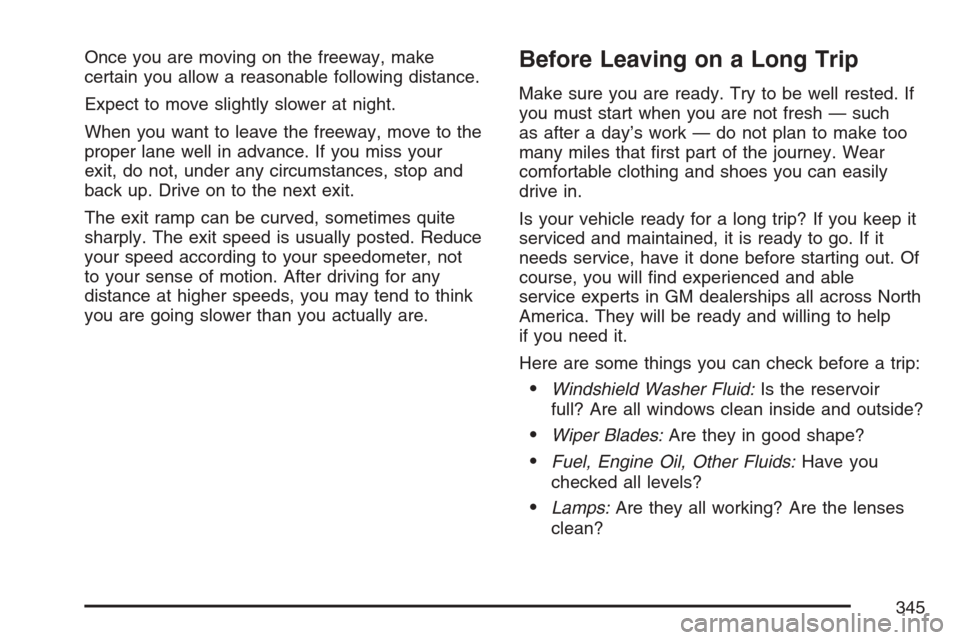check engine CADILLAC XLR V 2007 1.G User Guide
[x] Cancel search | Manufacturer: CADILLAC, Model Year: 2007, Model line: XLR V, Model: CADILLAC XLR V 2007 1.GPages: 512, PDF Size: 3.84 MB
Page 210 of 512

LEFT DOOR AJAR
This message displays anytime the engine is
running, the transmission is not in PARK (P), and
the driver’s door is open or ajar. A chime
sounds when the vehicle’s speed is greater than
3 mph (5 km/h).
LOW BRAKE FLUID
This message displays if the engine is running to
inform the driver that the brake �uid level is
low. Have the brake system serviced by your
dealer as soon as possible. See “Brake Fluid”
underBrakes on page 399.
LOW COOLANT
This message displays when there is a low level
of engine coolant. Have the cooling system
serviced by your dealer as soon as possible. See
Engine Coolant on page 385.
LOW FUEL
This message displays when the fuel supply is
less than 5 gallons (18.9 L) and the display
is turned off. A single chime also sounds when
this message is displayed.
LOW OIL LEVEL
For correct operation of the low oil sensing
system, your vehicle should be on a level surface.
A false LOW OIL LEVEL message may display
if the vehicle is parked on a grade. The oil
level sensing system does not check for actual oil
level if the engine has been off for a short
period of time, and the oil level is never checked
while the engine is running. If the LOW OIL
LEVEL message displays, and your vehicle has
been parked on level ground with the engine off for
at least 30 minutes, the oil level should be
checked by observing the oil dipstick. Prior to
checking the oil level, make sure the engine has
been off for a few minutes and your vehicle is on a
level surface. Then check the dipstick and add
oil if necessary. SeeEngine Oil on page 377.
LOW OIL PRESSURE
If this message displays while the engine is
running, stop the engine and do not operate the
vehicle until the cause of low oil pressure is
corrected. Severe damage to the engine can
result. A multiple chime sounds when this
message is displayed.
210
Page 211 of 512

LOW VOLTAGE
This message displays when the electrical system
is charging less than 10 volts or if the battery
has been drained. If this message displays
immediately after starting, it is possible that the
generator can still recharge the battery. The
battery should recharge while driving, but may
take a few hours to do so. Consider using
an auxiliary charger to boost the battery after
returning home or to a �nal destination. Make sure
you follow the manufacturer’s instructions. If this
message displays while driving or after starting
your vehicle and stays on, have it checked
immediately by your dealer to determine the cause
of this problem. To help the generator recharge
the battery quickly, you can reduce the load on the
electrical system by turning off the accessories.
You can monitor battery voltage on the DIC
by pressing the INFO button. The normal range is
11.5 to 15.5 volts.
LOW WASHER FLUID
This message displays when the windshield
washer �uid is low. Fill the windshield washer �uid
reservoir as soon as possible. SeeEngine
Compartment Overview on page 374for the
location of the windshield washer �uid reservoir.
Also, seeWindshield Washer Fluid on page 397
for more information.
MAX (Maximum) SPEED XX MPH
(XX KM/H)
This message displays when a failure in the
magnetic ride control system has occurred. The
Powertrain Control Module (PCM) determines
the speed to which your vehicle is limited. Have
your vehicle serviced by your dealer if this
message appears.
211
Page 216 of 512

SHIFT TO PARK
This message displays if the vehicle is not in
PARK (P) when the engine is being turned off. The
vehicle will be in accessory mode. Once the
shift lever is moved to PARK (P), the vehicle will
turn off.
STABILITRAK ACTIVE
You may see this message on the DIC. It means
that an advanced, computer-controlled system
has come on to help your vehicle continue to go in
the direction in which you are steering. This
stability enhancement system activates when the
computer senses that your vehicle is just
starting to spin, as it might if you hit a patch of ice
or other slippery spot on the road. When the
system is on, you may hear a noise or feel
a vibration in the brake pedal. This is normal.
When this message is on, continue to steer in the
direction you want to go. The system is designed
to help you in bad weather or other difficult driving
situations by making the most of whatever roadconditions will permit. If this message comes on,
you will know that something has caused your
vehicle to start to spin, so consider slowing down.
A single chime also sounds when this message
is displayed.
STABILITRAK READY
If this message displays and a chime sounds, the
system has completed the functional check of
the StabiliTrak
®System.
STABILITRAK WARMING
When you �rst start your vehicle and drive away,
especially during cold winter weather, this
message may display along with a chime and the
traction control warning light. This is normal.
You can acknowledge this message by pressing
the RESET button. The StabiliTrak
®System
performance is affected until the STABILITRAK
READY message is displayed in the DIC,
which can take up to 15 minutes.
216
Page 226 of 512

Here are some ways in which you can help avoid
distraction while driving.
While your vehicle is parked:
Familiarize yourself with all of its controls.
Familiarize yourself with its operation.
Set up your audio system by presetting your
favorite radio stations, setting the tone, and
adjusting the speakers. Then, when driving
conditions permit, you can tune to your favorite
radio stations using the presets and steering
wheel controls if the vehicle has them.
Notice:Before adding any sound equipment
to your vehicle, such as an audio system,
CD player, CB radio, mobile telephone,
or two-way radio, make sure that it can be
added by checking with your dealer. Also,
check federal rules covering mobile radio and
telephone units. If sound equipment can be
added, it is very important to do it properly.
Added sound equipment may interfere with the
operation of your vehicle’s engine, radio, or
other systems, and even damage them.
Your vehicle’s systems may interfere with the
operation of sound equipment that has
been added.Your vehicle has a feature called Retained
Accessory Power (RAP). With RAP, the audio
system can be played even after the ignition
is turned off. SeeRetained Accessory Power
(RAP) on page 89for more information.Theft-Deterrent Feature
THEFTLOCK®is designed to discourage theft of
your vehicle’s radio. The feature works
automatically by learning a portion of the Vehicle
Identi�cation Number (VIN). If the radio is
moved to a different vehicle, it will not operate. If
the radio is removed from your vehicle, the
original VIN in the radio can be used to trace the
radio back to your vehicle.
With THEFTLOCK
®activated, the radio will not
operate if stolen.
226
Page 285 of 512

Navigation Audio System
Notice:Before adding any sound equipment
to your vehicle, such as an audio system,
CD player, CB radio, mobile telephone,
or two-way radio, make sure that it can be
added by checking with your dealer. Also,
check federal rules covering mobile radio and
telephone units. If sound equipment can be
added, it is very important to do it properly.
Added sound equipment may interfere with the
operation of your vehicle’s engine, radio, or
other systems, and even damage them.
Your vehicle’s systems may interfere with the
operation of sound equipment that has
been added.
Your vehicle has a feature called Retained
Accessory Power (RAP). With RAP, the audio
system can be played even after the ignition
is turned off. SeeRetained Accessory Power
(RAP) on page 89for more information.
The audio system is operated using navigation
system menus. The audio menus are explained in
this section.
Main Audio Menu
e
/z(Audio/Adjust):Press this key to view the
main audio screen.
285
Page 327 of 512

Avoid needless heavy braking. Some people drive
in spurts — heavy acceleration followed by
heavy braking — rather than keeping pace with
traffic. This is a mistake. The brakes may not have
time to cool between hard stops. The brakes
will wear out much faster if you do a lot of heavy
braking. If you keep pace with the traffic and
allow realistic following distances, you will
eliminate a lot of unnecessary braking. That means
better braking and longer brake life.
If your vehicle’s engine ever stops while you are
driving, brake normally but do not pump the
brakes. If you do, the pedal may get harder to
push down. If the engine stops, you will still have
some power brake assist. But you will use it
when you brake. Once the power assist is used
up, it may take longer to stop and the brake pedal
will be harder to push.
Adding non-GM accessories can affect your
vehicle’s performance. SeeAccessories and
Modi�cations on page 363.Anti-Lock Brake System (ABS)
Your vehicle has the Anti-Lock Brake System
(ABS), an advanced electronic braking system that
will help prevent a braking skid.
When you start your engine and begin to drive
away, ABS will check itself. You may hear a
momentary motor or clicking noise while this test
is going on, and you may even notice that
your brake pedal moves a little. This is normal.
If there is a problem
with ABS, this warning
light will stay on.
SeeAnti-Lock Brake
System Warning
Light on page 193.
327
Page 338 of 512

If your vehicle starts to slide, ease your foot off
the accelerator pedal and quickly steer the
way you want the vehicle to go. If you start
steering quickly enough, your vehicle may
straighten out. Always be ready for a second skid
if it occurs.
Of course, traction is reduced when water, snow,
ice, gravel, or other material is on the road.
For safety, you will want to slow down and adjust
your driving to these conditions. It is important
to slow down on slippery surfaces because
stopping distance will be longer and vehicle control
more limited.
While driving on a surface with reduced traction, try
your best to avoid sudden steering, acceleration, or
braking, including reducing vehicle speed by
shifting to a lower gear. Any sudden changes could
cause the tires to slide. You may not realize the
surface is slippery until your vehicle is skidding.
Learn to recognize warning clues — such as
enough water, ice, or packed snow on the road to
make a mirrored surface — and slow down when
you have any doubt.
Remember: Any Anti-Lock Brake System (ABS)
helps avoid only the braking skid.Racing or Other Competitive
Driving (XLR-V)
See your warranty book before using your vehicle
for racing or other competitive driving.
Notice:If you use your vehicle for racing or
other competitive driving, the engine may
use more oil than it would with normal use.
Low oil levels can damage the engine. Be sure
to check the oil level often during racing or
other competitive driving and keep the level at
or near 2 quarts (2 L) above the upper mark
that shows the proper operating range on the
engine oil dipstick. For information on how
to add oil, seeEngine Oil on page 377.
After the competitive driving, remove excess
oil so that the level on the dipstick is not above
the upper mark that shows the proper
operating range.
338
Page 345 of 512

Once you are moving on the freeway, make
certain you allow a reasonable following distance.
Expect to move slightly slower at night.
When you want to leave the freeway, move to the
proper lane well in advance. If you miss your
exit, do not, under any circumstances, stop and
back up. Drive on to the next exit.
The exit ramp can be curved, sometimes quite
sharply. The exit speed is usually posted. Reduce
your speed according to your speedometer, not
to your sense of motion. After driving for any
distance at higher speeds, you may tend to think
you are going slower than you actually are.Before Leaving on a Long Trip
Make sure you are ready. Try to be well rested. If
you must start when you are not fresh — such
as after a day’s work — do not plan to make too
many miles that �rst part of the journey. Wear
comfortable clothing and shoes you can easily
drive in.
Is your vehicle ready for a long trip? If you keep it
serviced and maintained, it is ready to go. If it
needs service, have it done before starting out. Of
course, you will �nd experienced and able
service experts in GM dealerships all across North
America. They will be ready and willing to help
if you need it.
Here are some things you can check before a trip:
Windshield Washer Fluid:Is the reservoir
full? Are all windows clean inside and outside?
Wiper Blades:Are they in good shape?
Fuel, Engine Oil, Other Fluids:Have you
checked all levels?
Lamps:Are they all working? Are the lenses
clean?
345
Page 346 of 512

Tires:They are vitally important to a safe,
trouble-free trip. Is the tread good enough
for long-distance driving? Are the tires
all in�ated to the recommended pressure?
Weather Forecasts:What is the weather
outlook along your route? Should you
delay your trip a short time to avoid a major
storm system?
Maps:Do you have up-to-date maps?
Highway Hypnosis
Is there actually such a condition as highway
hypnosis? Or is it just plain falling asleep at the
wheel? Call it highway hypnosis, lack of
awareness, or whatever.
There is something about an easy stretch of road
with the same scenery, along with the hum of the
tires on the road, the drone of the engine, and the
rush of the wind against the vehicle that can makeyou sleepy. Do not let it happen to you! If it does,
your vehicle can leave the road in less than a
second, and you could crash and be injured.
What can you do about highway hypnosis? First,
be aware that it can happen.
Then here are some tips:
Make sure your vehicle is well ventilated, with
a comfortably cool interior.
Keep your eyes moving. Scan the road ahead
and to the sides. Check your rearview mirrors
and your instruments frequently.
If you get sleepy, pull off the road into a rest,
service, or parking area and take a nap, get
some exercise, or both. For safety, treat
drowsiness on the highway as an emergency.
346
Page 347 of 512

Hill and Mountain Roads
Driving on steep hills or mountains is different
from driving in �at or rolling terrain.If you drive regularly in steep country, or if you are
planning to visit there, here are some tips that
can make your trips safer and more enjoyable.
Keep your vehicle in good shape. Check
all �uid levels and also the brakes, tires,
cooling system, and transmission. These parts
can work hard on mountain roads.
{CAUTION:
If you do not shift down, your brakes
could get so hot that they would not work
well. You would then have poor braking or
even none going down a hill. You could
crash. Shift down to let your engine assist
your brakes on a steep downhill slope.
347